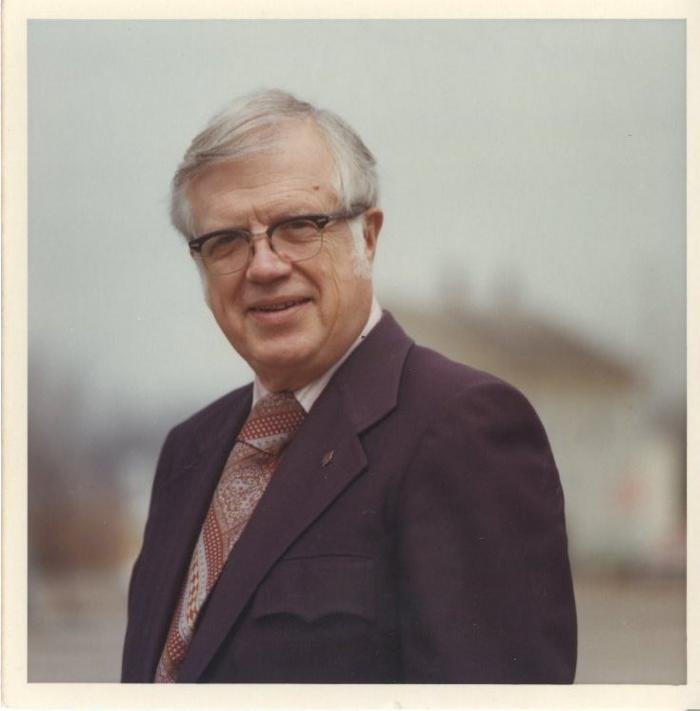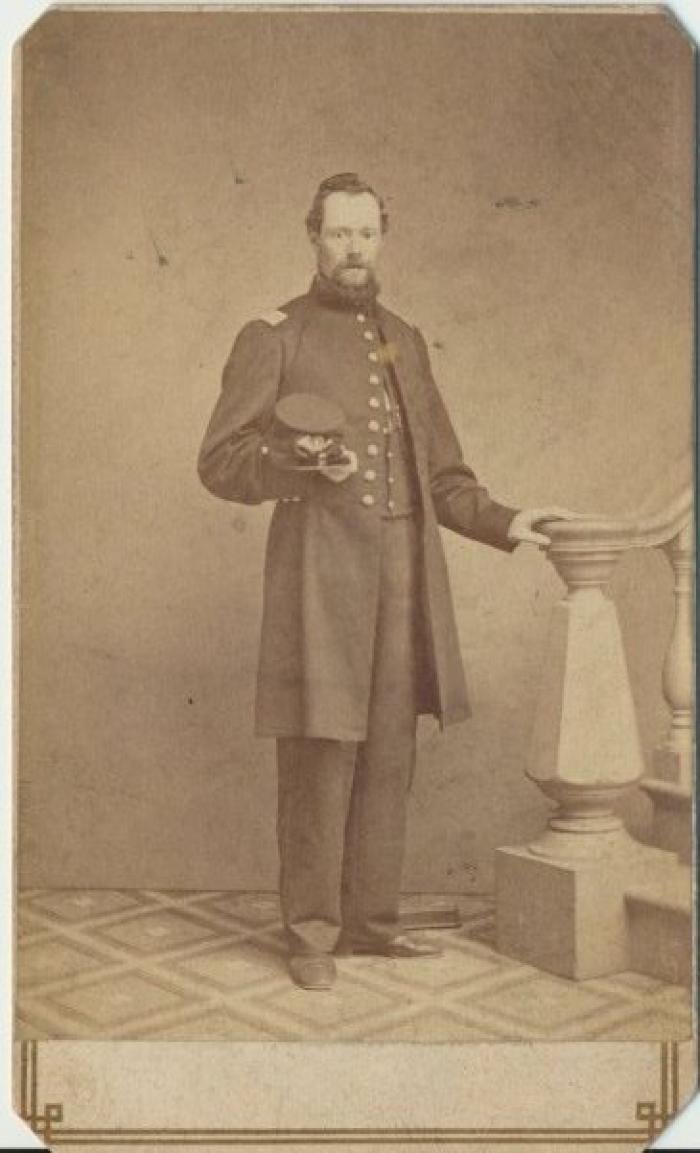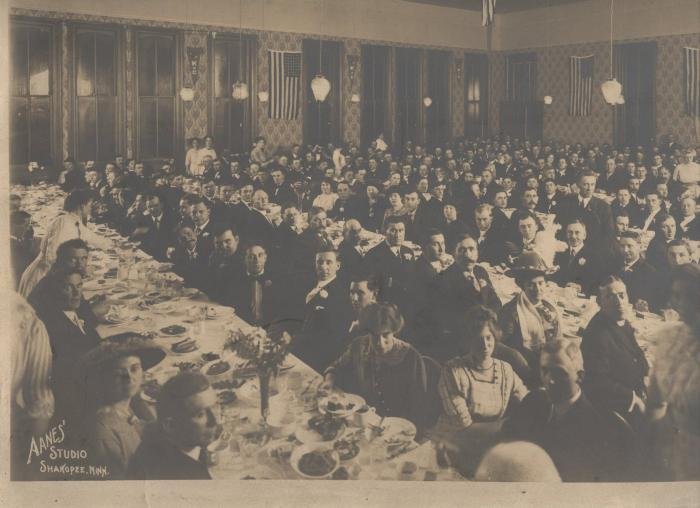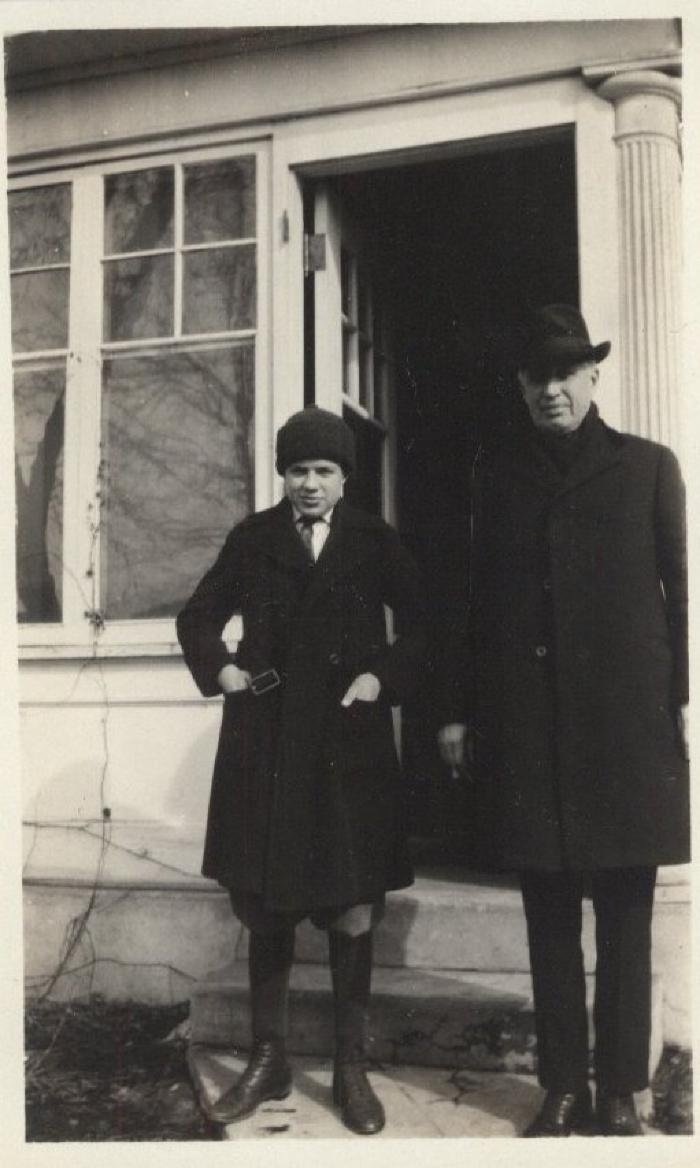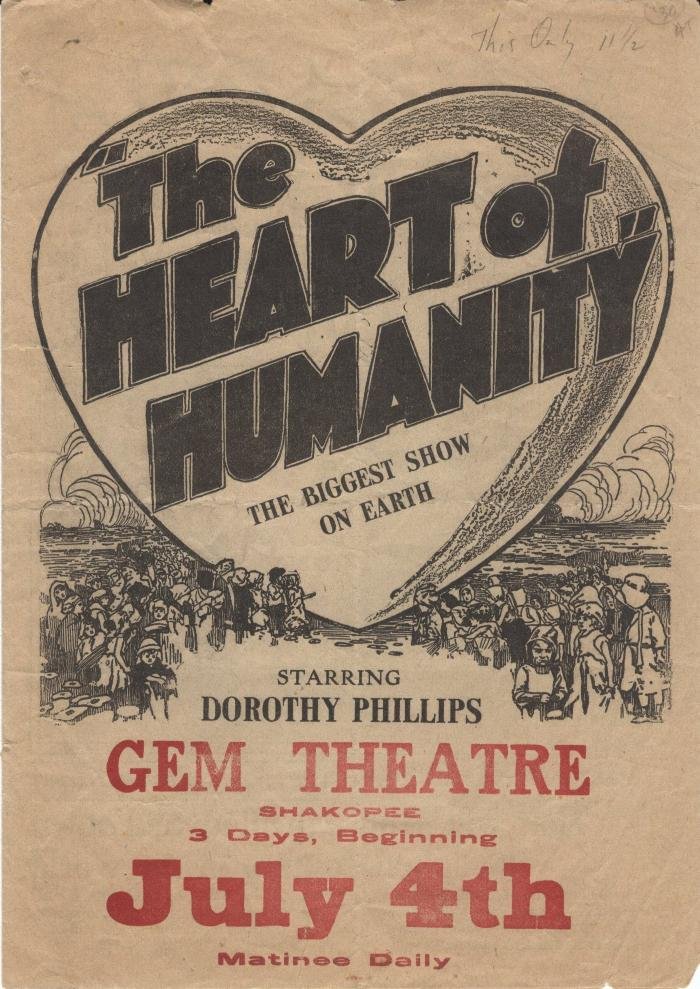Life in Shakopee: As Told By Julius Coller
Julius Coller (1970). Scott County Historical Society.
Julius (Jac) Anthony Coller II was a local historian, born in St. Paul on May 10, 1909, and raised in Shakopee. His parents were Julius A. Coller I, a state senator, and Cora E. Dennis from Iowa. He attended St. Mark’s school and Shakopee High School, graduating in 1928. In 1932, he graduated from the University of Minnesota with a history degree and went on to practice law. From 1935-1990 he served as Shakopee’s city attorney.
As a descendant of Shakopee’s earliest settlers and an avid history buff, Coller wrote the Shakopee Story, a comprehensive history of the city. He was also a guest on TTO, a radio show, during the 1970s and 80s where he spoke about the city’s past, creating oral histories. These oral histories give a glimpse of Shakopee in the early 20th century.
Coller died in 2000 at the age of 90 and left behind a legacy– one that we wish to share with you. This exhibit is a testament to his memory as we dive deep into life in Shakopee way back when.
Disclaimer: Coller often refers to the Mdewakanton and Dakota nations as “Sioux,” Native Americans as “Indians,” and events like the US-Dakota War of 1862 as the “Sioux Outbreak.” We have chosen to use more contemporary terminology in our exhibition summaries; however, the recordings still have the old terminology in them. It has been kept in for research and educational purposes only.
Early City Government
Shakopee was home to the Mdewakanton Dakota people for thousands of years until 1851 when the Mendota Treaty of 1851 was signed and settlement in the region became available. This treaty, along with the Treaty of Traverse des Sioux, forced the Dakota out of the lands of southern Minnesota. On May 23, 1857, Shakopee was incorporated as a city and Nathan M. McMullen was elected as the first mayor of Shakopee. Throughout Shakopee’s history, there were many people who cared about their city’s progress. For example, when the Minnesota State Legislature approved an act to repeal the city charter of Shakopee in 1861, many of the townspeople voiced the desperate need for Shakopee’s reincorporation, claiming the population and economic growth of their town were sufficient enough to make it a city. In 1870, the Legislature granted Shakopee cityhood again and a new charter was adopted. Horace B. Strait, a veteran of the Civil War, was elected mayor. Under Strait, the city council introduced many ordinances such as the regulation of liquor licenses. This ordinance, along with many others, caused a lot of controversies. According to Coller, the ordinance increased the price of owning a license, which limited many businesses. Many people viewed the ordinance as too restrictive and unfair.
Citizens were not only passionate about their businesses but their privacy as well. Sewers in Shakopee during this period were practically nonexistent and many homeowners had outhouses on their properties. But in 1909 the city council passed an ordinance to create lines of sewers in Shakopee. This ordinance included assessing each section of the sewers according to the property it landed on. The assessment affected the homeowners financially and many residents stood up in opposition claiming the assessment was unconstitutional and a violation of privacy. However, in 1911, the Minnesota Supreme Court deemed the city’s ordinance constitutional, and the sewers were established, modernizing Shakopee’s infrastructure.
In 1925 history was made when the first woman mayor of Shakopee was elected. Elizabeth K. Ries was the daughter of Jacob Ries, owner of the local company, Ries Bottling Works. She was an experienced businesswoman and entrepreneur and when she was elected into office, she wrote to the city council outlining the goals she wanted to accomplish. During her time as mayor, she promoted transparency in government and the modernization of the city. One goal she achieved was updating the roads by creating a wagon that sprinkled water onto the dirt road, preventing dust from accumulating in the air. This made the streets safer and cleaner. She also helped create committees to reroute the state highway and construct new roads between neighboring towns, like the Holmes Street Bridge, to connect Shakopee to the rest of the Minnesota Valley.
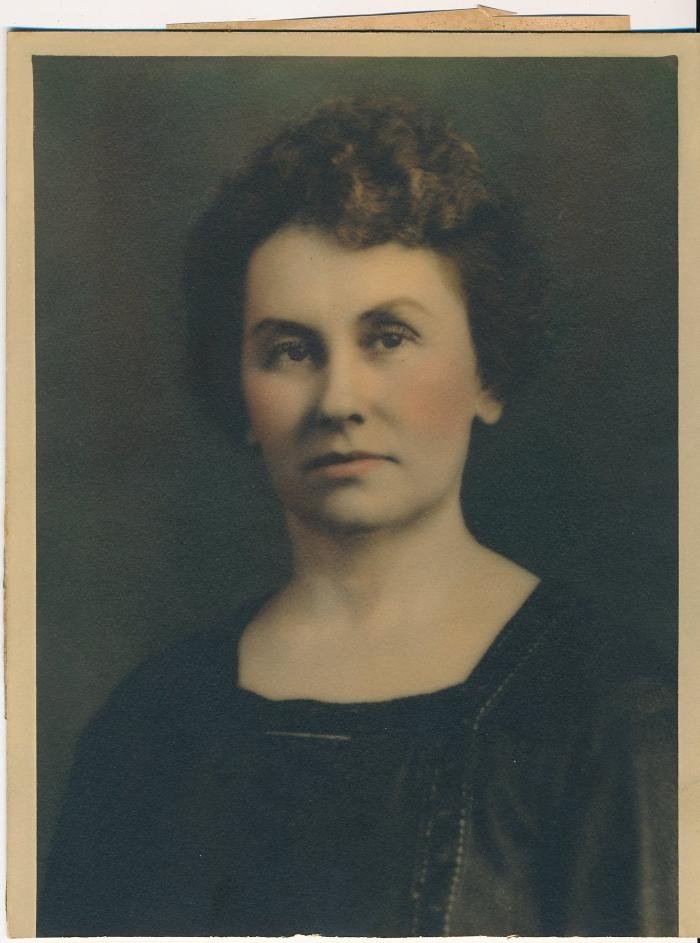
Local Churches
First Presbyterian Church
First Presbyterian Church was founded by Samuel Pond in 1855. Samuel and his brother, Gideon, were Presbyterian missionaries from Connecticut who arrived in Minnesota in 1834. The brothers focused their work on ministering to the local Dakota nations along the Minnesota River Valley. However, after the Mendota Treaty in 1851, the brothers left their mission with the Dakota and began ministering to the new white settlements in the region. Gideon left for Oak Grove while Samuel founded the first presbyterian church in Shakopee. The first church was built in 1856 and was truly a community effort. Pond states that the money used to build the church was raised via a festival the women of the congregation put on for the community. Furthermore, members of other denominations aided in the building too. These efforts brought the community of Shakopee closer together as Pond notes that the “different branches of the Christian church [showed] their Christian spirit, and unity of purpose… working in harmony with one another.” Indeed, the church did bring the varying denominations together as it became a sanctuary and meeting place for all of the Presbyterian, Methodist, and Baptist congregations. Among the various settlers coming from different regions and denominational backgrounds, the First Presbyterian Church represented community and camaraderie in the early days of Shakopee.
St. Mark’s Catholic Church
The German Neo-Gothic style church that towers over the city was built in 1868 and served both German-speaking and English-speaking Catholics in Shakopee. St. Mark’s first mass was held on January 6, 1856, in the home of a congregation member, Anton Entrup. That same year construction of the church began. In 1857 the Order of St. Benedict (OSB) took control over the parish and continued building the church until 1862 when construction halted and soon after, the US-Dakota War began. In 1864, the English-speaking Catholics separated from St. Mark’s to form St. Mary’s church, and the next year St. Mark’s resumed construction of the building. On December 8, 1868, the building of St. Mark’s was completed and dedicated. In 1869 the OSB left Shakopee and Diocese priests took over, led by Reverand Gregory Koering. In 1917, the church underwent a major renovation. Coller recalls that prior to 1917, the church was in great need of renovation. According to him, the floors were white wooden boards and the stone walls were plastered and would get water stains on them from the frosts in early winter. The new renovation replaced the floors, walls, gallery, and windows, and installed a new heating plant, bringing St. Mark’s interior into the 20th century.
St. John’s Lutheran Church
St. John’s Lutheran church dates back to 1860. Under the direction of Reverand Blumer, the first pastor, the church was organized. The congregation witnessed its first sacraments such as the baptism of Henry Gebhardt and the marriage between Louis Welker and Mary Best. In 1862, the church was incorporated as the “German Evangelical Congregation church” and in 1869, its first building was erected and it was reincorporated as the “First Evangelical Lutheran church.” By 1890, the congregation moved again to First Avenue. At this location, the church hosted many celebrations for the whole community including its golden jubilee in 1910. The day began with church services followed by a picnic out on the lawn with entertainment from a college band. In 1953, the church moved once again to its current location. The Argus reported that hundreds of people came in celebration of the new building’s dedication.

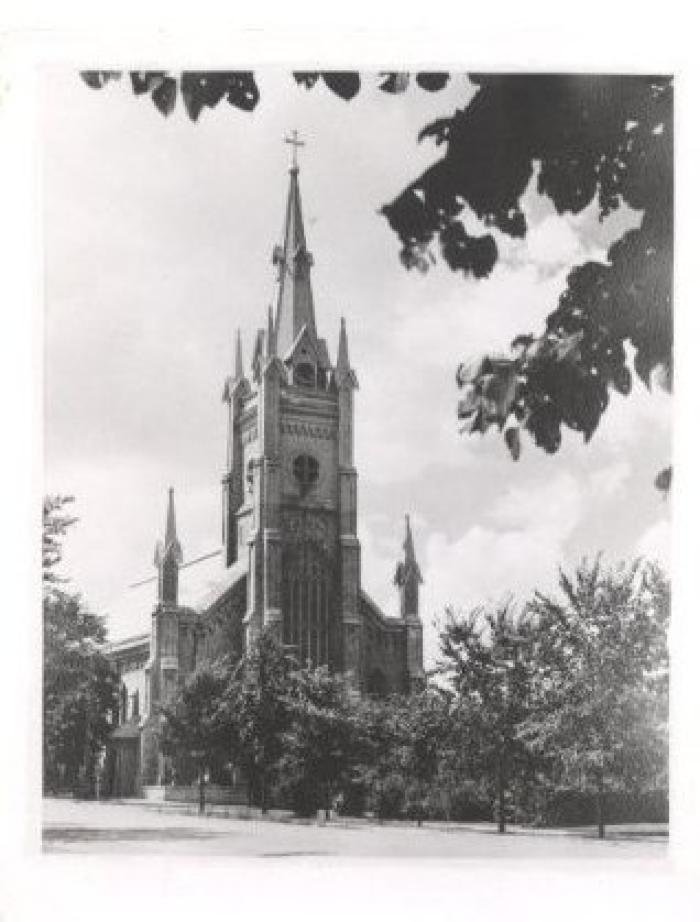
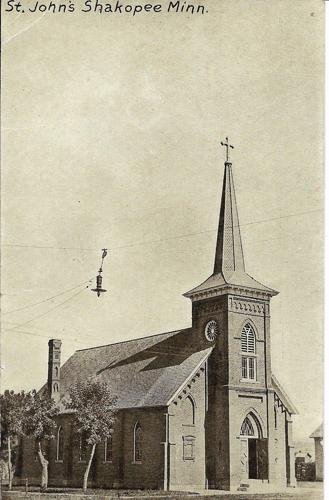
Industries
Railroads
The first prominent industry living in Shakopee was the railroad. The first railroad in America was built in 1827 and was followed by a complete network of railways connecting everyone in America to each other. The first train to enter Shakopee came thirty-eight years later on November 11, 1865, under the Minnesota Valley Railroad Company. A few years prior, the State Legislature was deciding where to place these railways in Minnesota, and Shakopee claimed they were the perfect spot for a junction because they were on a “direct line” from the metro railway routes to the rest of the Valley. It appears that Congress agreed because the construction of the railroad began soon after. Having a railroad in Shakopee would impact its economy immensely. Farmers and businessmen would be able to send their goods to the metro area of St. Paul or down the Mississippi river to benefit their businesses, and the railroad made communication and travel faster than ever. Further, passengers from various regions of Minnesota could visit Shakopee more easily and one could also send mail by train and communicate with loved ones who lived far away. The railroad was an employer as well and in the 1870s, a locomotive shop, run by St. Paul and Sioux City railroad companies, was built in Shakopee. It was an essential part of the economy before the 1890s when the shop was moved out of Shakopee to St. Paul and Wisconsin.
Breweries and Pop Factories
If you enjoy a nice cold glass of soda, or a beer on a hot day at any of Shakopee’s downtown establishments, you might have enjoyed what was offered over a hundred years ago! In the 1850s, Shakopee was home to the Shakopee Brewery, which was built and owned by H.H. Strunk until 1872 when it was sold and became the Nyssen Brewery. The establishment brewed various alcohols that were made available at the local saloons downtown. If you had stopped at one of those saloons back then, you would have partaken in beverages such as lager, buck, or porter beers; bourbon, Monongahela whiskeys, brandy, gin, or wine. Strunk’s business is historically the first brewery and distillery in the Minnesota River Valley and it contributed to the city of Shakopee by providing employment and “good ale” for sixty-five years until 1920 when it was shut down during the Prohibition.
Not a big fan of ale? You might have liked the soft drinks made by the Jacob Ries Bottling Works company. Jacob Ries was an immigrant from Luxembourg who opened a pop factory in Shakopee in 1872. He made his drinks using a spring he tapped which he called “Rock Spring.” This product was renowned in the Midwest and even won two awards at Chicago’s World’s Fair in 1893. In the 1920s, his daughter, Elizabeth Ries opened the Rock Spring Restaurant. If you lived in Shakopee during this time, you might have come into the restaurant to find a rich menu filled with breakfasts, sandwiches, steak dinners, ice cream, and pastries along with their famous soft drinks. Coller found the Rock Springs drinks to be quite delicious, noting his favorites being lemon soda, creme soda, and ginger ale.
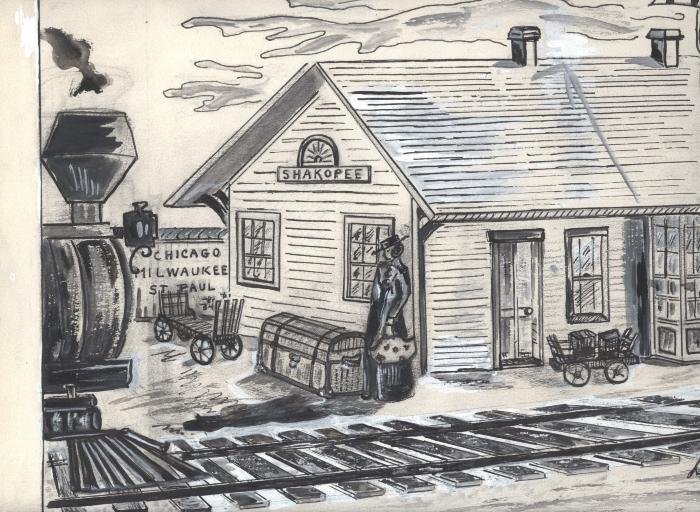
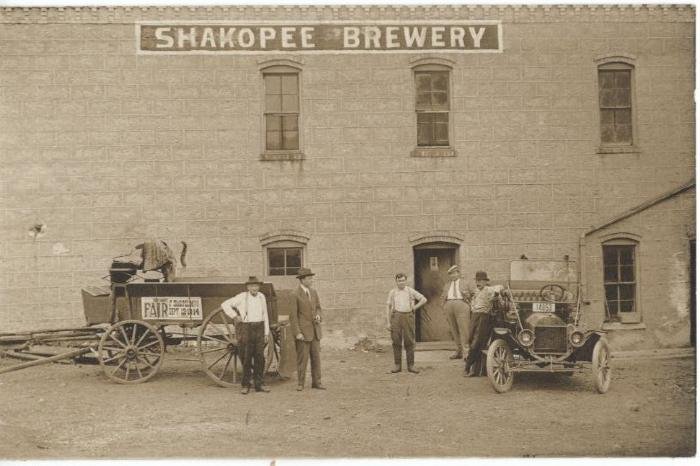

Fraternal Organizations
Fraternal organizations have been present in America since the 18th century. These organizations were societies of men with the goal of caring for their communities, donating to charities, and pursuing knowledge. The first prominent fraternity in Shakopee was King Solomon’s Lodge. First organized in 1783 in Charlestown, MA, it eventually made its way to Minnesota in the 19th century, and on October 28, 1863, King Solomon’s Lodge was established in Shakopee. The second most prominent in the area was the Knights of Columbus. The Knights began as an order in Connecticut on March 29, 1882, and arrived in Shakopee on April 20, 1913. Among the members of these societies was Coller’s father.
Today, the Knights of Columbus is still involved in the community by hosting bake sales and donating to charities and organizations in need, and St. Mark’s church works in close collaboration with the Knights to serve the community. Back in the 20th century, these fraternal societies would similarly give to the community. One example would be throwing banquets for the people of Shakopee to attend. These parties were always quite elaborate and included dinner, speeches, performances, and dancing. One source describes one of the events writing that “a sumptuous banquet was held at the Opera House, which was beautifully decorated with flags and K.C. [Knights of Columbus] banners fitting to the occasion. Plates were laid for three hundred and a four-course banquet served.” These parties were always a great way to meet friends and celebrate Shakopee’s community.
The Knights of Columbus Banquet (1915). Scott County Historical Society.
School
Shakopee’s school history is one of gradual progress. As early as the 1840s, there were small public schools dispersed throughout the territories, but it was not until 1870 that the first official public school would open. During its first year in operation, the first public school, District 41, had over one hundred and twenty students enrolled, ranging from the ages of six to eighteen. Coller’s father was a student there. There were a number of parochial schools and private academies, too. The earliest was St. Mark’s school which taught boys and girls when St. Mark’s church was first established. In 1883, it got its own schoolhouse adjacent to the church. St. Gertrude’s Convent and Academy was another institution that prepared girls for the career of a nun. It was incorporated in 1866 and ran as a school until 1880. The building then went on to be a rectory, a poorhouse, and the first location of St. Francis Hospital.
Shakopee had a number of schools, but in the 19th century, it was believed that the school system could be better for future generations. In 1855, a newspaper asked their readers to support the building of a new school house claiming that there was a lack of education for the local children. It is not entirely clear what has caused this lack. At the time, there were at least three district schools, but they were held in people’s homes or in the upper floors of business buildings. Plus, there was no education available above eighth grade. Perhaps the lack of space and higher education caused some children in Shakopee to miss out on their education. In 1870 when District 41 was built, it provided more space for children to be taught. Even then, the citizens of Shakopee thought it was not enough; They had a public school, but now they needed a high school. Over time, more people began to push harder for the city to provide higher education for their children. For instance, one article wrote, “Shakopee has entered a progressive state… our numbers are augmenting… Sons and daughters are placed on the stage of action without even possessing the rudiments of an elementary education… Education elevates and enlarges the sphere, both thought, and feeling… Then why delay? There ought to be sufficient capital tendered, without being solicited, to build this [high school].” Years later, in 1894, the first high school in Shakopee opened its doors.
Life as a student
So what did daily life look like for the average student in Shakopee? Students would have taken core classes in Latin, philosophy, rhetoric, mathematics, history, science, and music, somewhat similar to today. Schools provided unique classes as well, including the study and practice of agriculture. Students in the 1920s also would have participated in extra-curricular activities like a student would today. While there was no robotics club, there was a basketball team and a sewing club. For many years, schools in Shakopee did not provide lunch, so students brought lunch from home. In 1916 when the high school began to serve the kids hot lunches, they acknowledged that “a cold dinner on a cold day is not only unpalatable but injurious to health as well. Children ought to have something hot at noon.”
Graduations
Graduations are a big milestone for many students as they leave their childhood behind and begin their adult life, filled with all of the skills they had learned while at school. Graduations back then were not unlike what they are today. However, there was a greater emphasis on the presentation of the arts. Back then, graduations were held in June either at the school or at one of the many entertainment halls including Dawson’s or Berens’ Hall. The graduation ceremonies of the various schools all followed similar patterns. For instance, the commencements at District 41 and the high school included the students presenting projects, performing orations, or playing the piano followed by a series of speakers, presenting the diplomas, and a speech by the valedictorian, which usually concluded the event. Julius Coller II, who graduated in 1928, would have attended a very similar event for his graduation.
When looking back to schools in Shakopee during the late 19th and early 20th centuries, it can seem very familiar. Children back then learned and played similarly to children now, but it took a lot of effort from the early settlers to advocate for their children’s education and for the school system of future generations. Because of them, we have schools like Sweeney, West Middle, and Shakopee Senior High School for children to learn and grow.
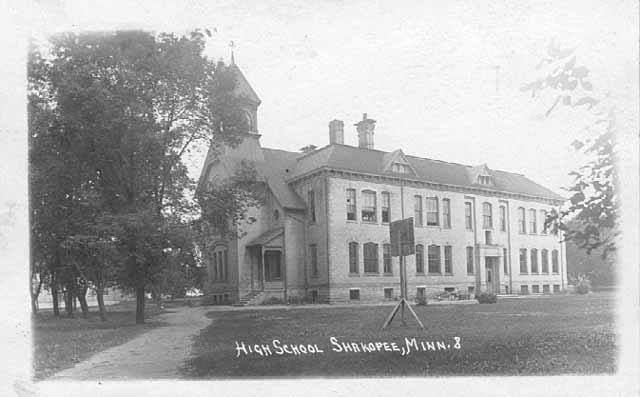

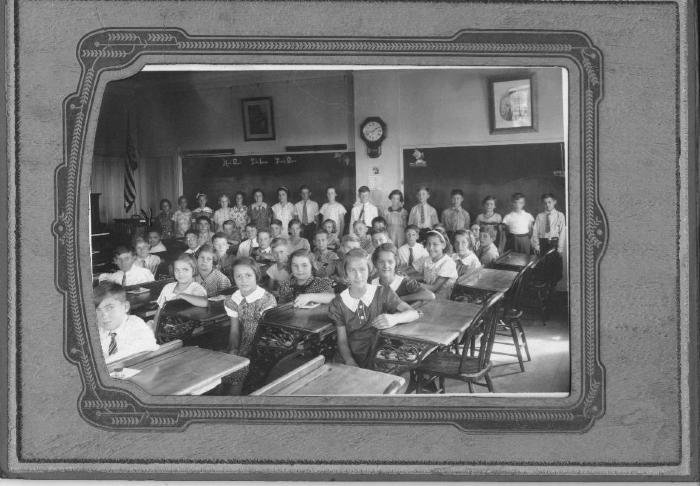
Seasonal Activities
Springtime
Springtime beginning in March reveals the blooming of flowers and the coming of warmer days. In Shakopee, the local residents celebrated the coming of spring in many different ways. One example is that they would put on spring-themed concerts. In 1915, students at the high school put together a concert and performed songs like “Blue Bird,” “Butterflies Hide and Seek,” and “Lady April.” They even crowned a May Queen at the event. Another way people would celebrate was by attending Easter balls hosted by fraternal societies. One, in particular, was held at an opera house by the Royal Neighbors society. Over two hundred men and women attended the event and it lasted from nine o’clock in the evening to three in the morning. The room was extraordinarily decorated to resemble the night sky; a paper box panted like the moon was hung in the center of the room, and paper boxes with lights inside had star shapes cut into them. These boxes were placed around the room and would project stars onto the walls and ceilings.
In late May, Memorial Day was one of Coller’s favorite springtime holidays. He recalls that Shakopee held a Memorial Day parade. These parades would have begun with the Grand Army of the Republic (a fraternal organization for veterans of the Civil War) holding a service at the Valley cemetery where people could decorate the graves of veterans. Then, everyone would gather at the Court House Square to begin the parade. It would make its way through Lewis, Spencer, and Fuller streets, ending at the Lewis Street bridge. Then, the sailors and marines would be commemorated at the bridge and the parade would make its way to Riverside Park (near Huber Park) for further celebrations.
Summertime
After the Memorial Day celebrations, summertime soon phased in with the arrival of June. In Shakopee, America’s favorite pastime made up an important part of the city’s culture. The opening of baseball season brought excitement to the entire city. The local baseball team was made up of young men playing against neighboring towns. The sporting event was often elaborate and brought many local spectators. In 1915, for example, Shakopee opened their season playing against Belle Plaine. A parade was led by a band that brought spectators to Riverside Park where the mayor would give a speech. Baseball was an exciting event and residents of Shakopee supported their teams with pride. One news article even speaks of the reliability of a player nicknamed “Shooty,” who they felt confident would help Shakopee win the game. When looking at the Shakopee Sabers today, it is evident that pride for our hometown teams has been a major part of our city’s culture.
At the end of summer, the most anticipated event of the season was approaching: The Scott County Fair. Although the fair is held in Jordan now, Shakopee had its own fair for several years. Beginning as an annual exhibition for the Agricultural Society in 1872, encouraging the practice of agriculture in the region, it steadily became an attraction that brought many to Shakopee’s streets. The fair took place in late August or early September on First Avenue between the streets of Holmes and Sommerville. Around the 1880s, the fair incorporated carnival acts like trapeze artists or sword swallowers into the fair attractions. By the 1920s, the fair moved to Riverside Park. As a child, Coller recalls the fair always had a vast array of produce, plenty of fine livestock, concerts, baseball games, dances, a parade, and fireworks. One year, he recalled there was an airplane on display and that an aviator would climb in, rev up the engine, and climb back out. The children, he said, were always waiting for the plane to fly into the air, but to their dismay, it never did. After the 1930s, the fair in Shakopee began to dwindle as the competing fair in Jordan began to rise in popularity. In 1972, the current site of the fair was purchased becoming the county fair we know and love today.
Autumn
Autumn seemed to be a season Coller appreciated the most. He reminisced about the changing colors of the sky, the aroma of burning leaves, and the harvest time when families would begin canning the goods from their gardens in preparation for the upcoming holidays. He notes that Sauerkraut, horse radish, and mince meat pies were the most popular items to make in the German community of Shakopee.
The first major autumnal holiday most people look forward to today is Halloween, but Coller says that in Shakopee, Halloween was a little different. “Trick-or-treating” was not a widespread tradition until the 1950s, but “tricks” were much more common in the 1920s. Coller remembers a friend of his would prank the local residents and businesses every Halloween. He recalled that one Halloween, he woke up to find his family’s lawn furniture stacked amongst other people’s belongings on the steps of St. Mary’s church, blocking the door. The next holiday, Thanksgiving, was a special occasion for the citizens of Shakopee since the early settlers. Back in the 1850s, early settlers and their families would host feasts serving turkey, venison, cranberries, and pumpkin pie; similar to today.
Winter
As the days got colder and the snow began to fall, winter came to Shakopee. Many children would play out in the snow or participate in winter activities. Coller recalls ice skating on the Minnesota River every year with his friends. As for holidays, they were always abundant during this time of year. As Shakopee had many ethnically German residents, St. Nicholas Day was a holiday largely celebrated. St. Nicholas Day is a holiday celebrated on the 5th and 6th of December, honoring the Catholic Saint Nicholas who was known for selling all of his possessions and giving to the poor. This holiday is accredited as the inspiration for Santa Claus. Traditionally it is celebrated by gift giving and legend says that if children leave out their shoes, Saint Nicholas will leave candy and gifts in them.
In the early 20th century, both Saint Nicholas Day and Christmas were largely celebrated, but Christmas was the most popular of any holiday. Local newspapers would advertise gifts for the whole family all throughout November and December. These advertisements give us a glimpse of what type of gifts might have been placed under the tree during this time. For example, ties, caps, handkerchiefs, and cigars were portrayed as the perfect presents for men while women’s gifts consisted of hosiery, mahogany serving trays, cutglass sugar containers, and creamers. Children’s gifts were often toys like rocking chairs or dolls.
Although presents were fun things to look forward to during Christmas, forward there was also the annual lighting of the community Christmas tree, which is still a tradition we have today. Beginning in the 1880s, the lighting of the Christmas tree was always a special community event. For a while, the tree was placed on the grounds of St. Mark’s church. On its grounds, it had bonfires placed strategically to keep spectators warm while local bands played for their entertainment. Santa Claus was present for the children, the mayor gave speeches and school children would sing carols. The last major holiday celebrated was New Year’s Eve. Much like today, people would host parties in their homes, or you could attend local events. Often Dawson’s Hall in the Opera House would throw a New Year’s party where there would be food and dancing through all hours of the night.
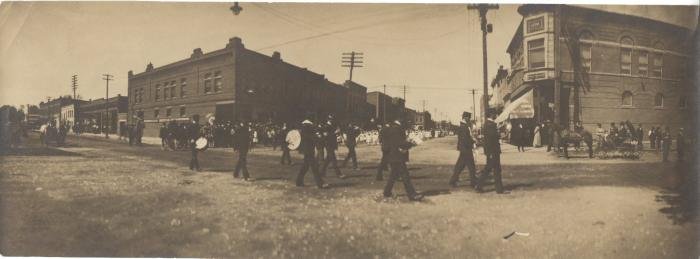
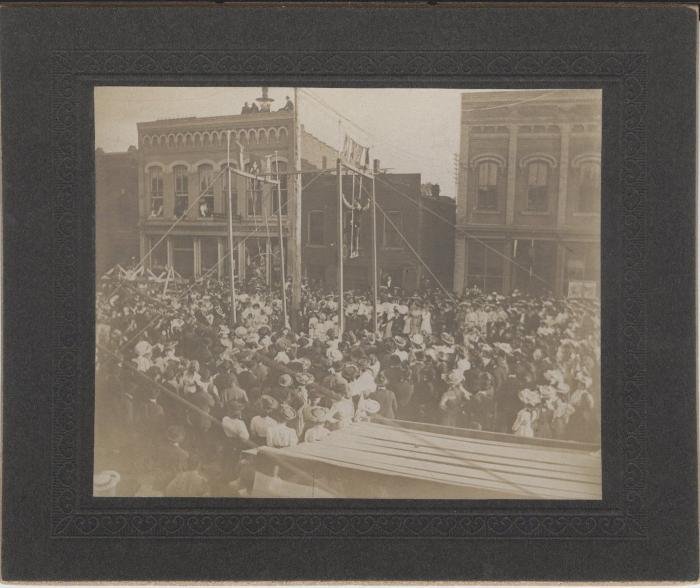
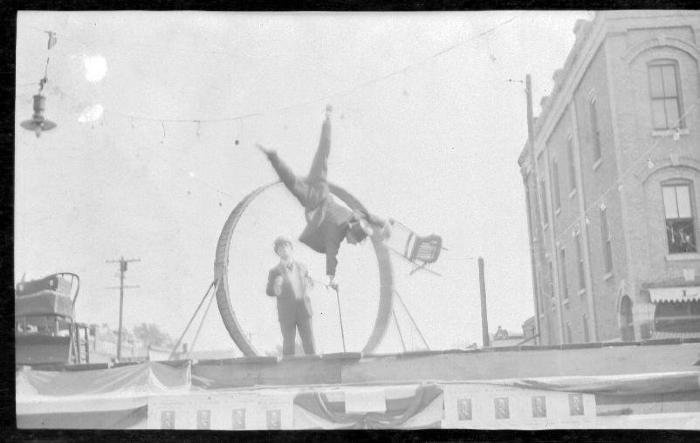
World War I in Shakopee
Coller was eight years old when the United States entered the First World War. While many of the young men and women of Shakopee were shipped off as soldiers or nurses, the rest of Shakopee’s population contributed their everyday lives to the war effort. What did that effort look like, and how did the war impact Shakopee as a community?
The Red Cross was an organization that provided relief for soldiers overseas and aided Americans in need during a period of food shortages and disease. In Shakopee, a chapter of the Red Cross was organized in 1917 with its chairman being Julius Coller I. The citizens of Shakopee donated food, clothing, and other goods to the Red Cross. For example, many women knitted socks for the soldiers and by September 1918, 1,350 socks had been made for the cause. As a child, Coller remembers helping his mother by holding the spool for her while she knitted.
Shakopee’s contribution was evident in other ways, too. For instance, during this time university students were encouraged to help America during the war by remaining in school. While many young men and women wanted to volunteer in the war, President Wilson urged students to remain in school by claiming that “Colleges and universities are organized primarily to train men and women for leadership in the various activities of life and in the affair of the nation… These leaders may very likely be lost in the cause.” The University of Minnesota among other colleges supported Wilson’s speech and encouraged their students to remain close to their studies so that the future generation of leaders would be prepared for the nation’s future affairs.
Although Shakopee accomplished a lot of good during the war by providing for their nation and soldiers, the stigma around those of German descent and ethnicity in Minnesota and in Germany brought division among friends and neighbors. As a community that was settled by many German immigrants, many institutions like St. Mark’s school once spoke and taught in German, but by the First World War, the language had practically disappeared. Likewise, propaganda films such as Heart of Humanity or The Kaiser: The Beast of Berlin were shown at the Gem theater in town, depicting Germans in a negative light. Although the community was heavily made up of German descendants, patriotism for America was stronger than cultural heritage during wartime. Even children participated in the division; Two young boys, Adolph Scheller (age 14) and Arthur Strehlow (age 12) engaged in a game of “war.” It was reported that Scheller wanted to “show the Strehlow boy the proper way to kill off a German".” Scheller, playing an American general, shot Strehlow, playing a German soldier, with a rifle which they believed was unloaded. Strehlow was not killed, but the game was a testament to the influence wartime had on both adults and children, and it shows the impact propaganda and anti-Germanism had on the town of Shakopee.
Advertisement for Heart of Humanity at the Gem Theater (1918). Scott County Historical Society.
CONCLUSION
Life in Shakopee during Coller’s youth shows how Shakopee has gotten to where it is today. From its government to its churches, schools, and more, the efforts of the early settlers and residents of this city have provided us with the institutions and culture we see today. However, while there was a lot of progress, there was hardship and discrimination here too. Thanks to Coller’s oral histories, we know our history so we can move forward and create a promising future for Shakopee.

